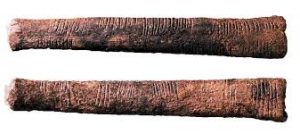Ishango Bone
 The numbers 3, 5, 7, 11, 13, 17 and 19 are prime numbers. Can you make a total of 60 from four of these numbers?
The numbers 3, 5, 7, 11, 13, 17 and 19 are prime numbers. Can you make a total of 60 from four of these numbers?
One of three columns of tally marks on The Ishango Bone gives the answer to this question. Found in the Ishango region of the Democratic Republic of Congo, it dates from the Upper Paleolithic era, about 18000 to 20000 BC. More about this later.
Can you make a total of 28 from these prime numbers in two different ways.
If you now include the prime numbers 19 and 23, can you now make a total of 49 from these numbers in two different ways.
From the prime numbers up to and including 31, can you find prime numbers that make a total of 79 in two different ways.
From the prime numbers up to and including 41, can you find prime numbers that make a total of 118 in two different ways.
This problem solving activity was inspired by the Ishango Bone. It has a sharp piece of quartz at one end and appears to have been a writing tool. There are many interpretations of the markings on the bone, and many theories about their significance, but it is remarkable that our ancestors in Africa were using numbers in what appears to be a sophisticated way.
Click here to download the Notes for Teachers.
South Africa COVID-19 News
Here is the official website for COVID-19 updates.
Login
SUPPORT AIMSSEC





